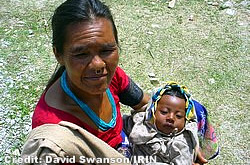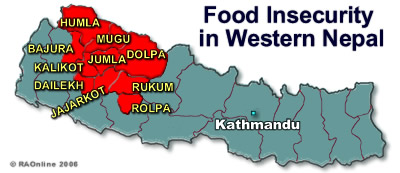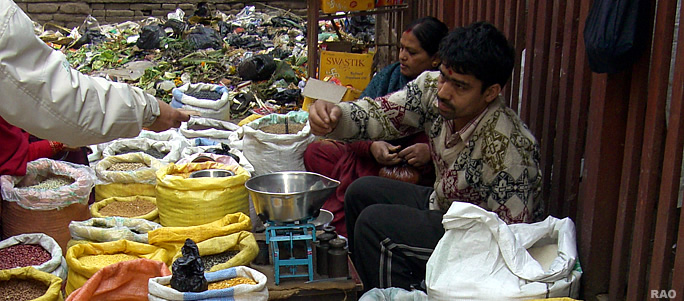| Development
in Nepal: Reports on Food Crisis |
 |
Nepal Development |
|
|
 |
|
Poverty-stricken
western areas most vulnerable to food-price hikes
|
 |
KATHMANDU,
6 May 2008 (IRIN)
Worldwide
food price hikes are particularly hitting remote villages in western Nepal,
the most food-deficit and impoverished part of the country, according to
food security experts.
"We
can't grow enough food. We have no source of employment. The rising food
prices are making our life very difficult," said Kanchi Biswakarma, a villager
from the remote hill district of Jumla, some 700km northwest of the capital,
Kathmandu.
Biswakarma
said her six-member family could afford only one meal a day. "If we eat
in the morning, we have to skip a meal at night," she said.
"My
whole family has to work as daily wage labourers to find enough money to
buy food," said Maneta Chettri, a villager from the remote Dolpa District.
Her children had to drop out of school to help her feed the family.
"The
potential food crisis is growing and the number of people vulnerable to
food insecurity has doubled in the last six months," WFP Nepal country
director Richard Ragan told IRIN.
 |
| One
of South Asia's poorest nations, Nepal has over eight million people (out
of a population of about 28 million) living below the poverty line of US$1
per day. Roughly half of these 8 million are regarded as the extreme poor,
who survive on less than 50 US cents a day, according to WFP.
Food
insecurity is nothing new to Nepal due to its low agricultural productivity
caused by droughts, natural disasters and poor farming practices and technologies,
say agriculture specialists. |
|
Less
food from India
Nepal
has been largely dependent on low-cost rice and vegetables from India.
The ban on exports since October 2007 of non-Basmati (cheap) rice from
India had caused a huge problem, said Ragan.
According
to local traders, India's supplies roughly meet 25 percent of Nepal's food
requirements.
 |
| The
Ministry of Agriculture estimated that the production of summer paddy would
be 17 percent higher this year, but it is likely that rice prices will
still increase by over 20 percent because of the lack of food imports from
India, according to WFP. The government's Central Bank of Nepal estimated
that the price of rice had increased by over 30 percent in the last three
months. |
|
However,
owing to lower incomes, people in remote hilly areas were most exposed
to the price hikes.
"I
used to pay only Rs 80 [US$ 1.27] for cooking oil and now it costs more
than Rs 120 [$1.90]. The cost of rice has increased from Rs 5,000 [$80]
to Rs 8,000 [$127] for a 100kg sack. Just imagine our hardship," said Sunita
Chettri from Dolpa.
Tens
of thousands of Nepalese migrate to India for seasonal work. This workforce
usually returns home every six months with enough money to buy food and
build up food stocks, but increasingly they are unable to do this, according
to WFP.
Both
China and India have rapidly expanding economies and rising food prices
and this is affecting Nepal, especially the poorest there.
WFP
officials said there was a need to set up programmes to build up farmers'
capacity, increase investment in agricultural development and most importantly
subsidise programmes for poor communities. In the interim, there was a
need to supply food for eight million Nepalese immediately.
Political
parties are in the process of forming a new government and there is uncertainty
as to how and when food security issues will be tackled, said aid workers.
"The timing of the potential food crisis has emerged in the middle of forming
the new government, so there will be challenges," said the WFP's Ragan.
Credit
IRIN 2008
Copyright
Ⓒ UN Office for the Coordination of Humanitarian Affairs 2008
[
This report does not necessarily reflect the views of the United Nations] |
 |
Integrated
Regional Information Networks (IRIN), part of the UN Office for the Coordination
of Humanitarian Affairs (OCHA).
| Links |
 |
 |
 |
External
link |
IRIN
News
|
 |
IRIN
News |
| more
information |
 |
|





